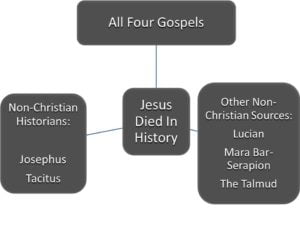Series: Evidence Pointing To Christ
- Answering Big Questions In Hopes That It Will Lead To Faith: Paul At Aeropagus (Acts 17:22-30)
- Reasons for Choosing to Believe the Bible
- The Bible: How Did We Get What We Have?
- Evidence for the Resurrection: Jesus Died By Crucifixion
- Evidence For The Resurrection: The Disciples Truly Believed That Jesus Rose From The Dead And That They Saw Him
- Evidence For The Resurrection: The Radical Change of Saul
- Evidence for the Resurrection: The Radical Change of James
- Evidence For The Resurrection: The Tomb Was Empty
As we approach the celebration of Easter I would like for us to look at historical evidence for the Resurrection itself. We have already looked at the reliability of the Scriptures over the past few weeks. We can have incredible confidence in the reliability of the Scriptures. And in the next few weeks television statements will have documentaries that tell very little of the story of the Scriptures. And I hope that you are prepared to read and see the things that will come at you in the coming weeks.
Knowing that the Scriptures are reliable is an incredible thing. But there is a miracle at the heart of what we believe that is very often doubted. That miracle is the Resurrection of Christ. And we will attempt to look at the historical evidence for the Resurrection of Christ.
The Miracle At The Center Of It All
Don’t overlook the importance of this. The core of what the Scriptures teach is the gospel. The word gospel means “good news”. We rebelled against our Creator and earned for ourselves the justice of that same Creator. God would have been completely and totally just to have abandoned His Creation and punished everyone. Yet, this is not what He decided to do. God, in His grace and mercy, decided to make a way for people to be saved from His justice. God sent His Son to come to Earth. His Son’s name was Jesus. Jesus willingly came to Earth, lived a perfect life, and died on the cross paying the full punishment for our sin. And after that, Jesus rose from the dead. Jesus’ rising from the dead was God’s stamp of approval on the sacrifice that Christ had made. He had sacrificed His life for the lives of those who would believe. God found it to be good. God found His sacrifice to be enough and He rose Jesus from the dead.
Dead people don’t rise from the dead. It just doesn’t happen. So it is understandable why people would find this to be unbelievable. Yet, what we find is that we have a good amount of historical evidence that points us to say without a doubt that this is in fact what happened.
A Cumulative Case For The Resurrection
In the weeks to come we will be building what is called a cumulative case argument for the Resurrection. This will remind you a lot of what happens in a court room. One piece of evidence is brought out….then another…then another…then another until we look at all of the evidence and see that the only conclusion that we could logically make is that Jesus Christ died and rose from the grave. We will see that any other conclusion is illogical.
This discussion of the Resurrection comes largely from the Book “The Case for the Resurrection of Jesus”. Before reading this book I had no clue about how strong the cumulative case for the Resurrection of Jesus actually was. And I encourage you to go read it. It was written by Gary R. Habermas and Micheal R. Licona.
An Aside About “A Vast Majority Of Scholars”
It is probably necessary to give a short aside concerning the idea of “a vast majority of scholars”. Most of the information that we will look at over the following weeks are different things that are accepted by “a vast majority of scholars”. Though the exact percentages would be hard to come by these things are accepted by nearly all of the people that examine this evidence. Four of the facts that we will look at are accepted by a “vast majority of scholars” and the last one is accepted by a majority of scholars.
We are not looking at all of the evidence for the Resurrection, but we are looking at very strong evidences for the Resurrection.
The First Evidence: Jesus Died
This seems a rather interesting place to start. But, I do believe that it is necessary.
Many people today doubt that Jesus even existed and it is necessary for us to see that Jesus died before we can prove that He rose from the dead. It just makes sense.
The important thing to look at is what do a majority of historians say about the death of Christ? Well, a vast majority of scholars believe that Jesus lived, and died by crucifixion. Now, why would they be so confident in this being the case?
The Gospels As Witnesses Of Jesus’s Death
Jesus’s death is recorded in all four gospels (Matthew 27:32-56; Mark 15:21-41; Luke 23:26-43; John 19). Some people hear this and say to themselves, “but can we trust the Bible?”. The fact is, yes. We can trust the Bible. As we have seen over the past few weeks, these were four different documents…not one. And these four different documents were written by four different people. And not only are these four different documents that are written by four different people, but 2 were written by eyewitnesses (Matthew and John), one was written by the close friend of an eye-witness whom church history states followed an eyewitness around recording what he said about it (Mark).
So, within the Bible that you hold today there is a reliable collection of eyewitness accounts detailing the death of Christ. Because of the reliability of Scripture that we discussed over the past few weeks this in and of itself becomes strong evidence for the Death of Christ.
Imagine that you were in a courtroom and heard from four different people, different perspectives concerning the death of Christ. 2 of them were eyewitnesses. One of them had taken a detailed account of the event from eyewitnesses. And yet another had heard the story from an eyewitness. To top it all off, there stories have some differences of perspective. This is important because if you hear 4 identical stories you might as well only have one witness because those folks got together so that they could tell the same story. That’s not what you in these accounts. You get the same story told from different perspectives. We have a strong case for the death of Christ in only what is written in the gospels.
This, by itself becomes strong evidence for the death of Christ. Interestingly, it doesn’t stop there.
The Record Of Non-Christian Historians
Interestingly, it is not only Christians who speak of Jesus’ death, there are also trusted non-christian historians giving accounts of Jesus’s death. One such historian is Josephus.
Josephus was a First Century Roman-Jewish Historian. His works have been widely distributed and read. Historians, Theologians, and Preachers today study his works because of the massive amount of importance. Josephus records Jesus and James’s brother in Antiquities 20.9.1 and then,
“When Pilate, upon hearing him accused by men of the highest standing among us, had condemned him to be crucified…”–Antiquities 18.3.3
Both of these records place Jesus as living and the second one discusses His being condemned to death.
Josephus is not the only historian from the first century to have record of Jesus. There is also Tacitus. He is considered likely the greatest first century Roman Historian. He had this to say about Jesus.
Nero fastened the guilt [of the burning of Rome] and inflicted the most exquisite tortures on a class hated for their abominations, called Christians by the populace. Christus, from whom the name had its origin, suffered the extreme penalty during the reign of Tiberius at the hands of one of our procurators, Pontius Pilate-Cornelius Tacitus, Annuls 15.4.4
To me this is wildly interesting because it isn’t really about Jesus’s death. It’s about the burning of Rome. But apparently the death of Christ is so settled in the mind of this historian that he just mentions it as a sidebar so as to identify those people whom he is discussing.
These two are the most widely read and known historians to report Jesus but they are not the only non-Christians who discuss Jesus. Lucian of Samosota is a Greek Satirist and Mara Bar-Serapion is an Assyrian Philosopher who both are non-Christians who mention the death of Christ. We also find it in one of the texts that are central to Judaism. It is a commentary on Jewish History, Law, Customs, and Culture called the Talmud. However, its report on the death of Christ is very short. It simply says,
“on the eve of the Passover Yeshu was hanged”
We Can Be Sure That Jesus Died
As far as history is concerned this a sure thing. You have the four accounts in Scripture from eyewitnesses along with the historical accounts of the first century from non-Christian sources as well as other discussions of Jesus from antiquity and His mention in the Talmud. We can be sure that Jesus died.
What Does This Mean For Us?
First, it means that the first evidence for the Resurrection of Christ sits in place quite firmly. It is not a disputed fact because of the large amount of historical evidence that supports it.
Second, Scripture teaches that the purpose of this death was the salvation of people from God’s justice. God sent His Son to pay the full penalty for the sin of His people. The death of Christ was about paying the punishment for sin. And it happened in history.
Summary For Those Who Want To Present This Later

In summary we have the first line of evidence being that Jesus died in history. The vast majority of scholars believe that Jesus existed and died because of the evidence for this having taken place. Here is the evidence.
- The eyewitness accounts found in all four gospels.
- Non-Christian Historians discuss the death of Christ.
- Other Non-Christian Sources discuss the death of Christ.
This is strong evidence for part one of Evidence for the Resurrection of Christ.
R. Dwain Minor



Trackbacks/Pingbacks